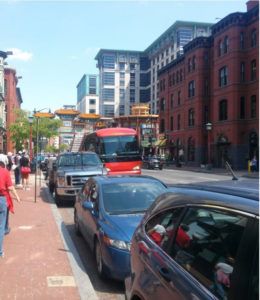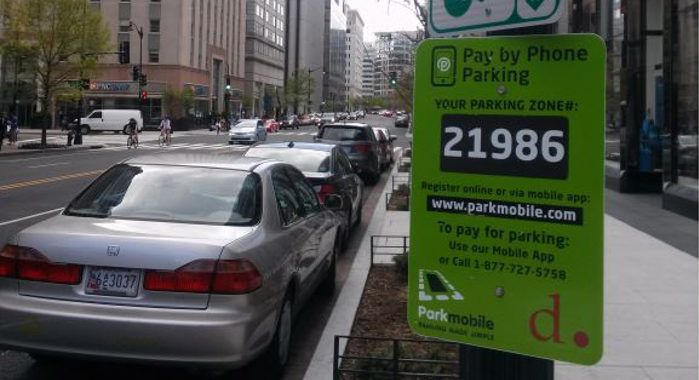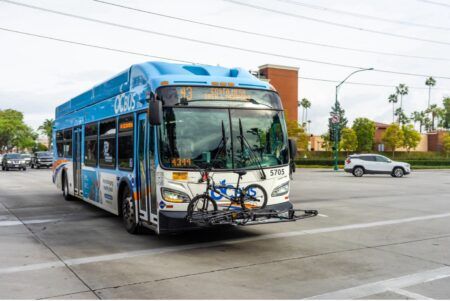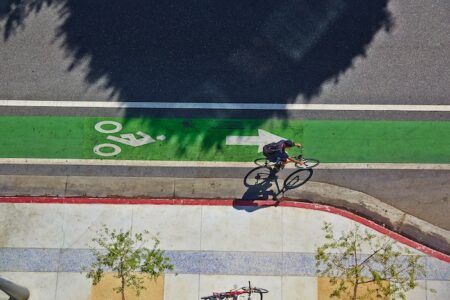Washington DC’s District Department of Transportation (DDOT) has released the final report on the success of its parkDC demand-based pricing parking pilot in the Penn Quarter/Chinatown area of Washington DC. The pilot began in 2014.
The study area included on-street parking spaces bounded by H Street NW, 3rd Street NW, E Street NW and 11th Street NW. The pilot was designed to reduce the time needed to find parking, improve turnover of high-demand parking spaces, provide better parking information to motorists, and reduce congestion by adjusting prices based on observed demand for parking on a block-by-block basis. During the pilot, DDOT applied demand-based pricing principles to on-street parking and commercial loading zones. The pilot also tested more cost-effective methods of collecting and disseminating parking availability data, information on parking availability and rates. The information was made available via two apps, parkDC and VoicePark, to help travelers make more informed decisions when visiting the area.
 At the start of the pilot, 62% of block spaces had the desired level of use (demand matched supply). This had increased to 72% at the end of the pilot. On high-demand blocks, occupancy stabilized as the price to park went up. When DDOT increased time limits in addition to lowering prices on low-demand blocks in the eastern portion of the pilot area, the blocks experienced a 12% increase in occupancy and a 14-minute increase in length of stay during weekday evenings. Customers parking in the pilot area self-reported a seven-minute decline in the time to find parking. After DDOT implemented demand-based pricing, the amount of time vehicles spent cruising for a spot decreased by as much as 15% during all time periods, while weekday congestion decreased by 5% and travel time reliability improved by 5% in the pilot area.
At the start of the pilot, 62% of block spaces had the desired level of use (demand matched supply). This had increased to 72% at the end of the pilot. On high-demand blocks, occupancy stabilized as the price to park went up. When DDOT increased time limits in addition to lowering prices on low-demand blocks in the eastern portion of the pilot area, the blocks experienced a 12% increase in occupancy and a 14-minute increase in length of stay during weekday evenings. Customers parking in the pilot area self-reported a seven-minute decline in the time to find parking. After DDOT implemented demand-based pricing, the amount of time vehicles spent cruising for a spot decreased by as much as 15% during all time periods, while weekday congestion decreased by 5% and travel time reliability improved by 5% in the pilot area.
Recently presented at the 2019 Transportation Research Board (TRB) annual meeting and conference, the report shows that based on data from the pilot project, DDOT found that:
• Parking availability increased on high-demand blocks, and underused spaces found more takers;
• Better information from DDOT helped drivers understand when and where they could park, and where spaces were available;
• Circling for parking decreased, as did overall traffic congestion;
• Applying pricing to loading zones began to address issues with double parking and illegal use of loading zones;
• The program did not negatively affect local businesses;
• The pilot area still has high use of non-driving transportation modes.
Based on the success of the pilot, DDOT is continuing demand-based pricing in the Penn Quarter/Chinatown area and is looking to expand the approach to other performance parking zones in the future.
“This innovative pilot advanced a cost-effective approach for managing our curbside. We leveraged technology, data and real-time information to enable more effective use of curbside space by residents, visitors and commercial vehicles over the last four years,” explained DDOT’s director, Jeff Marootian. “Such a data-driven and technology-enabled approach is increasingly important as we work to meet Mayor Bowser’s goal of making the District a multimodal city.”





